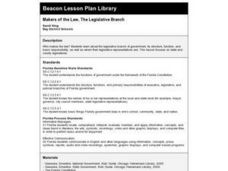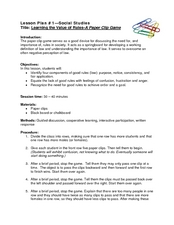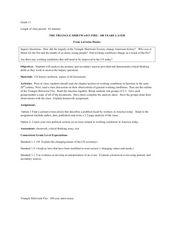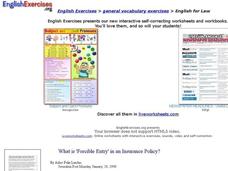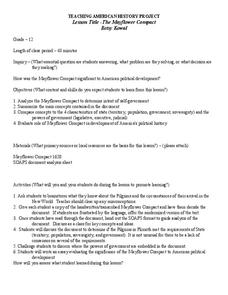Curated OER
Makers of the Law, The Legislative Branch
Young scholars, in teams, research the legislative branch and complete a "Legislative Information List." Teams research different parts of the list and jigsaw teach the other groups about each part. One group researches names of state...
Curated OER
Know The Code
Students explore how codes of conduct guide our daily lives. After learning about specific codes of conduct, students write articles exploring aspects of different codes and how they affect people in their community.
Curated OER
Is It Right to Bear Arms?
Students explore the debate on how to curb gun violence in America. They prepare an argument for or against a strict interpretation of the Second Amendment of the United States Constitution and participate in a debate.
Curated OER
A Civil Action
Students explore the roles of law enforcement officials, the news media, and civilians in crime prevention and criminal apprehension. They envision ways to build and strengthen community partnerships to address concerns about crime.
Curated OER
Mock Congress
Students get involved in the legislative process of law-making by assuming different roles and working with contemporary issues. Working in small groups, students write and work on different bills. Evaluation rubric included.
Curated OER
Life Savers?: Exploring Ethical Dilemmas Regarding AIDS Treatment in South Africa
Students participate in a roundtable forum to discuss the notion of defying South African national government policies in order to fight AIDS after reading the online article, "A Bold Move on AIDS in South Africa."
Curated OER
A Day in the Life of Bill C-One
Students explore the procedures that make bills into laws, identify the sources of opinion that form debates, bills, and laws and engage in part of the process by discussing whether or not a bill should become a law.
Curated OER
Thinking About our Rights and Freedoms
Students explain when and why the Canadian Charter of Rights and Freedoms became law, list two important rights or freedoms contained in the Charter and apply the law given in the handouts to the facts of the story to arrive at two...
Curated OER
Did Jack break the law?:
Learners identify the process for settling a legal dispute, identify key players in a legal dispute (who presents the facts; who makes the final decision) and determine what makes a decision fair.
Curated OER
That's MY Pencil: Simplified Mock Trial
Learners identify the process for settling a legal dispute, identify key players in a legal dispute (who presents the facts; who makes the final decision), and determine what makes a decision fair.
Curated OER
Thinking About Violence: Sexual Assault
Young scholars explain how the law defines a sexual assault, explain how the law views "consent" in a sexual encounter, extract a list of relevant facts from two stories and decide if the female has consented to sexual activity given the...
Curated OER
The Case of the Plugged Toilets:
Students identify the process for settling a criminal dispute (how are the facts of the case presented; how is the dispute resolved?, and
Curated OER
Government is News: Studying the Constitution
Sixth graders explore the United States Constitution. In this social studies instructional activity, learners discover how a bill is made into law, study the election process, and identify specific elements of the Bill of Rights.
Curated OER
Learning the Value of Rules - A Paper Clip Game
Using a game, learners discuss laws and fairness in society. In order to play the game, they line up in rows in the classroom. The teacher gives them paper clips based on their sex or other criteria. They can begin to discuss issues of...
Curated OER
The Triangle Shirtwaist Fire: 100 Years Later
Eleventh graders examine the impact of the Triangle Shirtwaist Fire. In this American History lesson, 11th graders analyze various sources. Students create a cartoon representing the impact of this fire on the United States today.
Curated OER
From A Bill To A Law
Students read about and discuss how a bill becomes a law and then propose a law themselves. In this law lesson plan, students learn legislative vocabulary and then brainstorm a law a write a letter proposing that law.
Curated OER
Don't Have to and Mustn't Exercise
In this grammar worksheet, students differentiate between choice and prohibition. Students insert either 'don't have to' or 'mustn't' to complete the sentences.
Curated OER
English for Law
In this law worksheet, students match words with definitions about the law and complete a crossword. Students complete 2 activities.
Curated OER
The Mayflower Compact
Twelfth graders discover the ideas of our government by reading the Mayflower Compact. In this U.S. Government lesson, 12th graders identify the main ideas of the Mayflower Compact, how it came to be and who was affected the most by...
Curated OER
Boy Scout Merit Badge: Law
In this boy scout merit badge: law worksheet, 8th graders research the topic with websites listed, answer 11 detailed questions about the definition, functions, history, role in society, and careers in the field of law.
Curated OER
Rules, Who Needs Them?
Students host a guest speaker. For this rules and laws lesson, students play a game to introduce rules and laws, discuss the need for laws and rules, complete a handout and listen to a person in law enforcement talking about the reasons...
Curated OER
Laws - Who needs them?
Students examine the need for laws. For this government lesson, students participate in 2 classroom activities that require them to consider the impact of laws on their personal lives. Students discuss how laws solve societal problems...
Curated OER
Law in the Future
Students develop a legal system. In this justice system lesson, students examine case law in the Untied States and draw on that experience to create a legal system for a "moon colony" which integrates the legal systems on Earth.
Curated OER
How is Our Government Organized?
Students explore rights of their clients. In this constitutional law lesson, students play an online game that requires them to review individual cases in order to determine the rights their clients have.


